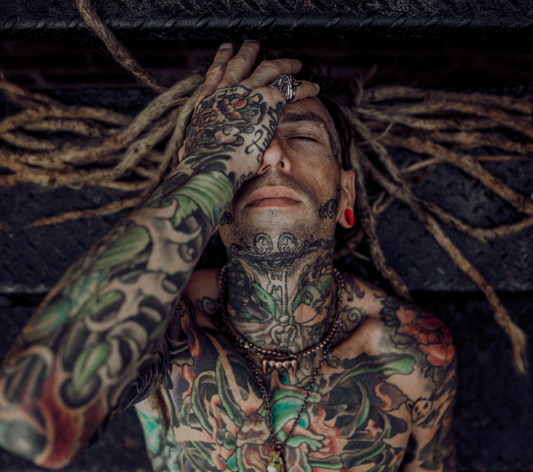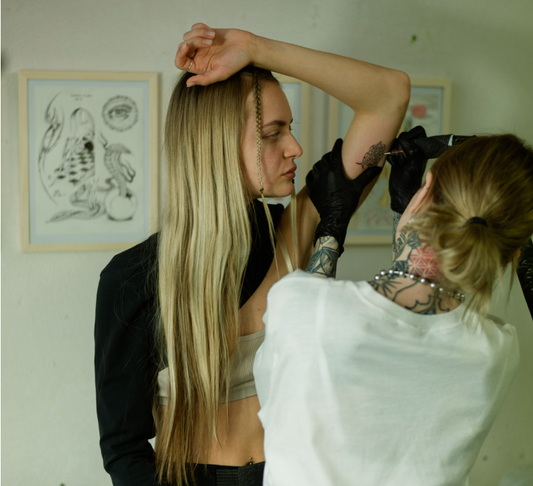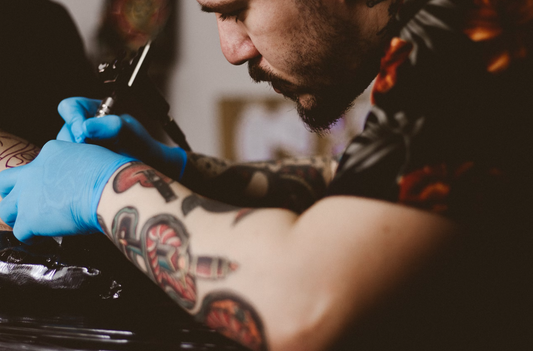Deciding to get a tattoo is a big step, but choosing where to place it can be just as crucial. While beauty is in the eye of the beholder, pain is something we all want to minimize. You've probably heard that some spots are more sensitive than others, but do you know which areas top the list for being the most painful?
From the ribs to the ankles, certain body parts are notorious for causing a bit more wincing and gripping the chair tighter. Whether you're contemplating your first tattoo or looking to add to your collection, understanding the pain levels associated with different tattoo locations can help you prepare mentally and physically. Let's dive into the spots that might make you think twice—or at least brace yourself a bit more—before the needle touches your skin.
Shoulders
When considering a tattoo, shoulder placement often comes up as a popular choice due to its visibility and the ample space it offers for intricate designs. However, it's crucial to understand the varying pain levels when getting inked in this region.
The shoulder is an area that's generally considered moderate in terms of pain level for tattoos. This is because the skin here has fewer nerve endings compared to other parts of the body. But, it's not just about the number of nerve endings. The shoulder has a thick layer of skin and muscle, which acts as a cushion during the tattooing process, reducing the intensity of the pain experienced.
That said, the closer the tattoo gets to the collarbone or the shoulder blade, the higher the pain tends to spike. The collarbone area, with its proximity to bone and lack of muscle or fat, can lead to a more intense tattooing experience. Similarly, the shoulder blade area, though muscular, has points where the bone is just beneath the skin, making certain angles and motions more sensitive during the process.
For many, the endurance needed for shoulder tattoos is manageable, making it a favored spot for both newcomers and seasoned tattoo enthusiasts. It's also an ideal location for larger pieces that require multiple sessions, allowing for an easier healing process due to the lower friction and movement compared to more mobile areas of the body.
When planning for a shoulder tattoo, it's advisable to:
- Wear comfortable clothing that allows easy access to the shoulder area.
- Prepare for varying levels of discomfort depending on the exact location and your pain tolerance.
- Discuss any concerns about pain or placement with your tattoo artist before starting.
Remember, each person's pain threshold is different. While some find shoulder tattoos to be a breeze, others may find them more challenging. It's all about knowing your body and preparing accordingly.
Spine
When considering a spine tattoo, brace yourself for a different level of intensity. The spine, a narrow stretch running down your back, is lined with nerve endings making it a highly sensitive area. As you explore this option, understanding the unique challenges linked to spine tattoos is crucial.
Pain Level Explained
The pain level for spine tattoos is often described as sharp and intense. Given the close proximity to the bone and lack of muscle or fat to cushion the needle's impact, each stroke can feel more pronounced compared to fleshier areas. It’s not just about pain tolerance; it's about preparing for a sensation that’s distinctly more acute.
What to Expect
- Immediate Discomfort: Expect a sharp, penetrating pain that directly correlates with the needle’s proximity to the bone.
- Vibration Sensation: Many report a vibrating feeling that can extend to other parts of the body, making the experience uniquely unsettling.
- Increased Sensitivity: Areas where the skin is thinner or closer to the bone will heighten the pain experience.
- Pain Management: Discuss pain management options with your tattoo artist. Some studios offer numbing creams, though opinions on their efficacy vary.
- Breaks Are Key: Given the intensity, don’t hesitate to ask for breaks. This can help manage the pain and give you brief periods of relief.
- Aftercare Awareness: The spine is a tricky area to heal given its constant movement. Follow your artist’s aftercare instructions meticulously to avoid complications.
Embarking on a spine tattoo journey demands a level of preparedness and awareness about what you’re walking into. It’s a commitment not just to the art but to enduring a higher tier of discomfort for the sake of something truly distinctive. Discuss thoroughly with your tattoo artist to set realistic expectations and ensure the final piece is worth the challenges faced during the process.
Ribs
When considering a tattoo, the ribcage is often highlighted as one of the most painful areas to get inked. This is due to the thin layer of skin and the proximity to bone. Moreover, when the needle hits the ribcage, the vibration can cause an intense, sometimes unbearable sensation.
- Thin skin and close to bone
- Vibration causes intense sensation
The pain level on the ribs can vary significantly from person to person, but it's commonly described as a sharp, constant pain that intensifies with every stroke of the tattoo needle. Additionally, the ribcage area expands and contracts with each breath you take, making it a challenging spot for both the artist and the individual getting tattooed.
Your pain tolerance plays a significant role in your experience. It's essential to prepare mentally and ensure you're in good physical condition before committing to a rib tattoo. Strategies such as deep breathing techniques can help manage the pain.
Before your appointment, discuss with your tattoo artist any concerns you have about the pain and inquire about their experience with rib tattoos specifically. Some artists might offer numbing creams as an option to mitigate pain, though opinions on their effectiveness vary.
Proper aftercare is crucial for rib tattoos, not only to alleviate discomfort during the healing process but also to ensure the longevity of the tattoo design. Tight clothing should be avoided to reduce irritation, and it's pivotal to follow the cleaning and moisturizing guidance provided by your tattoo artist.
Choosing to tattoo the ribs shouldn't be taken lightly. While it's an area that can result in stunning, personal artwork, being prepared for the intensity of the pain is essential. Incorporating breaks during the session may also aid in managing the overall discomfort.
Sternum
When considering a tattoo, the sternum is often brought up in discussions about pain. Sternum tattoos are known for their beauty and the unique way they accentuate the body's natural lines. However, they're also notorious for the level of discomfort they can bring. This area, being directly over the bone and nestled between the ribs, has a high pain factor due to the thin layer of skin and close proximity to bone structure. The vibrations from the tattoo needle can feel more intense here, giving a sensation that's described by many as one of the more painful tattoo experiences.
The pain you'll feel during a sternum tattoo session can vary widely. Factors such as your pain tolerance, the size and complexity of the tattoo design, and even your psychological state at the time can influence the level of discomfort. It's not just the pain during the session you'll need to prepare for; the healing process can also bring a certain level of discomfort due to the tattoo's placement. Given its location, the sternum area is often in motion due to breathing and movements, which can affect healing times and pain levels.
To mitigate the pain when getting a sternum tattoo, communication with your tattoo artist is key. Discuss pain management options available – some studios may offer numbing creams or may recommend over-the-counter pain relief options to take before your session. It’s also crucial to position yourself comfortably and remain as still as possible during the tattooing process to minimize pain from movement. Moreover, wearing loose-fitting clothing can significantly help in reducing irritation post-session, ensuring a smoother healing process.
The allure of sternum tattoos is undeniable, with their ability to transform the body into a canvas of personal expression. Their striking appearance, however, comes with the need for careful consideration of the pain involved and preparation for the experience. Being well-informed and prepared can make the journey of getting a sternum tattoo more bearable and ensure the outcome is as beautiful and satisfying as envisioned.
Ankles
When it comes to picking a spot for a tattoo, the ankles might seem like an appealing choice due to their visibility and the potential for small, delicate designs. However, it's important to bear in mind that this area can rank high on the pain scale. The ankles have a thin layer of skin and are in close proximity to bone, which amplifies the sensation of the needle. Furthermore, the lack of fatty tissue and muscle in this area means there's less cushioning when the tattoo needle hits the skin.
The pain experienced during an ankle tattoo can vary significantly from person to person, but it's often described as a sharp, intense sensation. This is especially true for the inner ankle area, which is more sensitive due to the higher concentration of nerve endings. The outer ankle, while still painful, might be slightly less so due to its slightly thicker skin.
Here are some factors to consider:
- Pain Tolerance: Knowing your own pain threshold can help you prepare mentally for the experience.
- Size and Complexity of the Design: Larger, more intricate designs may require longer sessions, which can increase discomfort.
- Artist's Technique: Every tattoo artist has their own method. Some techniques may feel more intense on the ankles than others.
Preparing for an ankle tattoo involves not only bracing yourself for the pain but also ensuring you have discussed pain management strategies with your tattoo artist. Wearing loose-fitting shoes or sandals post-tattoo session can help minimize irritation during the healing process. Proper aftercare is vital for maintaining the integrity of the design and easing any discomfort in the days following your tattoo session. Like with any tattoo, keeping the area clean and moisturized will support a smoother healing journey.
Choosing to get a tattoo on your ankles is a decision that should be made with an understanding of the pain involved. Knowing what to expect can help you better prepare for and manage the discomfort associated with this tattoo location.
Conclusion
Choosing the right spot for your tattoo is crucial not just for the design but for your comfort during and after the process. Whether it’s the moderate discomfort of a shoulder tattoo or the intense sensation of getting inked on the spine ribs sternum or ankle understanding what you’re in for can make all the difference. Remember to wear comfortable clothing communicate openly with your artist about pain management and follow aftercare instructions to the letter. Knowing your pain threshold and preparing both mentally and physically will help you endure the process and ensure the best outcome for your new piece of art. With the right preparation and care you'll be able to proudly show off your tattoo no matter where on your body you choose to place it.
Frequently Asked Questions
What are the most painful areas to get a tattoo?
Areas with a thin layer of skin and close proximity to bone, such as the ribcage, sternum, and ankles, are known to be the most painful spots for getting a tattoo. The pain in these areas is often described as sharp and constant.
How painful are shoulder tattoos?
Shoulder tattoos are generally considered moderate in terms of pain level due to their thicker layer of skin and muscle. However, the pain can increase near the collarbone or shoulder blade, where the skin is thinner and more sensitive.
What can be done to manage tattoo pain?
Discussing pain management options with the tattoo artist, wearing comfortable clothing, preparing mentally and physically, using deep breathing techniques, and taking breaks when necessary can help manage tattoo pain.
How should I prepare for a rib tattoo?
Preparing for a rib tattoo involves being in good physical condition, using deep breathing techniques to manage pain, discussing any concerns with the tattoo artist, and ensuring you're mentally prepared for the sharp and constant pain.
What is important to consider for an ankle tattoo?
For ankle tattoos, consider your pain tolerance, the size and complexity of the design, and the artist's technique. Prepare for the pain, discuss pain management strategies with your artist, and follow proper aftercare to minimize discomfort.
How does the pain of a spine tattoo compare to other areas?
Spine tattoos are described as having sharp and intense pain due to the close proximity to the bone and lack of cushioning. This makes them more painful compared to areas with more muscle and fat.






